admirable characters
by Glenn Roberts
Photography by Glenn Roberts
|

Honda - Kawasaki - Suzuki - Yamaha
|
|
Welcome to the fifth installment in our six part series featuring the motorcycles of the Bar Hodgson Collection. This issue we look at a sampling of the collections most significant motorcycles from Japan. The following bikes are considered milestones in the North American market when it comes to the Japanese motorcycle invasion and in many cases set the standard for others to follow. There were many similarities between the Japanese and the European motorcycle markets after World War II. Both were in a post war economy and in dire need of economical personal transportation which translates to clip-on engines for the common bicycle. By the time the 60's had rolled around the Japanese manufacturers were known to possess quality machine tooling equipment, advanced techniques and savvy commercial initiative. This was a time when the motorcycle firms of the world were taking serious notice of the Japanese two wheeled industry. Soon the Japanese bikes were faster and smoother than their British counterparts, and luxuries like comfort, disc brakes and electric start not to mention dependable high speed engines that didn't leak oil, all this offered at a reasonable price. By the late 60's, the British motorcycle industry was on a downward slope and the Japanese were starting their ascent on the next curve of the world's motorcycle trade. |

|
Honda:
Born in 1906, Soichiro Honda was the son of the village blacksmith in Hamamatsu, Japan. At age 16, Honda left home for Tokyo where he apprenticed to become an auto mechanic and later returning home to open his own auto repair business. Business was good allowing Honda to begin a successful part-time career in auto racing securing him an average speed record which remained unbroken for 20 years. A serious accident, however, ended his racing career.Japan was rapidly industrializing when Honda opened a factory producing piston rings. An earthquake leveled the plant completely in 1945, finishing the work of allied bombs one year prior. Japan, like most other war ravaged industrialized nations, had a shortage of transportation which had to be both inexpensive to purchase and to operate. As luck would have it, Honda happened upon 500 army surplus engines which he bolted to the frames of regular bicycles resulting in the first Honda motorcycle. Honda being a self taught engineer, built his first two wheeler in 1947 after World War II. Those first 500 motorcycles sold fast prompting Honda to produce his own engine and purpose-built frame. The Honda motorcycle was still belt driven until 1949 when Honda released the 'D' model, or 'Dream', with a two speed gearbox and chain drive. In 1950, Honda's quality, dependability and the establishment of a large dealer network made Honda the largest motorcycle manufacturer in the country accounting for almost half of Japan's motorcycle production.
|
|
Honda travelled to Europe and the United States in 1952 buying over 1 million dollars of new production equipment. If it weren't for some future minded bankers who could envision Honda's potential, he would have had to declare bankruptcy because of his equipment purchases.
Shortly after, an attempted hostile take-over of the company by Mitsubishi was overcome, Honda was on his way to greatness. There were over 100 motorcycle manufacturers in Japan in the 50's all vying for marketshare. This resulted in a price war which saw a lot of the small manufacturers close their doors. Honda's mass production abilities allowed the company to produce motorcycles far more economically than many others and the company survived unscathed. Honda's desire to build technically advanced machinery was evident even in 1952 when he designed and built a 3 valve per cylinder 4 stroke engine. Although producing high performance engines is what Honda would have preferred to build, Japan was still reeling from being at war and low cost consumer transport was still the company's main source of income. Three quarters of Honda's production, 6,500 units per month, was the 'Cub', a bolt-on engine that delivered power to the rear wheel of a regular bicycle. 1955 saw another milestone for Honda. The Dream SA was powered by a 250cc 4 stroke engine with overhead camshaft. Later the Dream SB had a 350cc engine and was Honda's largest engine to date. In the late 50's, the Japanese market was beginning to get saturated with motorcycles so Honda set his sights on exporting. Many countries were recovering from the post war economies and the small bolt-on engine sales were beginning to slow. Cars were still too expensive but the larger motorcycles were now seeing better sales. In 1958, Honda released the Super Cub C100, a scooteresque machine that the world was ready for. A larger, more comfortable ride due in part to the faired weather protection it provided and enclosed engine attached to an automatic clutch. An easy to ride, step-through motorcycle was the answer for Honda and helped put the company on the world map. The first 5 months of production saw 24,000 units built and 15 million units by 1983. Many incarnations of the C100 have been produced using the same principle and are still in production today albeit with newer technology. Honda's Super Cub marketing campaign targeted the general public, not existing riders, to buy the product claiming 'You meet the nicest people on a Honda'. Worldwide sales for the step-through skyrocketed and introduced many new riders to the motorcycle market in general. Without doubt the most successful motorized two wheeler of all time. Honda's first twin cylinder engine arrived on the market in 1957 and became a big hit in Europe. An overhead cam, all aluminum construction that could rev high and did not leak oil. All that and reliability made the Honda a very desirable motorcycle to own. It was because of Honda's racing experience that he was able to develop high revving dependable aluminum engines. They had some success racing in Japan but the early 60's saw wins at major races like the Isle of Man TT and the Ulster GP. Machines like the 5 cylinder 125cc and the 6 cylinder 250cc were capturing wins as well as the hearts and imaginations of race fans worldwide. The first real challenge to British and European manufacturers was the CB450 in 1965. The CB450 sported an overhead cam, torsion bar valve springs and could rev to 8,500rpm to produce 43hp. The 5 speed gearbox could propel the CB450 to 100mph easily, as fast as a 650 British bike. Although the Super Cub C100 had a major impact on Honda's success and recognition, another one of Honda's motorcycles had an immense impact on how the world viewed Honda the CB750. If the advertising for the C100 was targeting non-riders, the advertising target for the CB750 was existing riders who wanted more power and luxurious features like electric start, disk brakes and a 5 speed transmission at an affordable price. The CB750, released in 1969, was a clean, uncomplicated motorcycle that offered outstanding value for the money and was not only fast in a straight line but it handled good in a corner as well. The CB750 was a huge success causing the other motorcycle manufacturers reason for concern. The CB750 was a stepping stone for many off-shoots large and small, and the basis for more advanced engines shortly after its release. The name Honda is known worldwide, possibly more than any other motorcycle manufacturer because of the enormous dealer network and their dependability but also because of the many other vehicles and power products the company produces.
|

|
1966 Honda 305 Dream
|
|
Overhead camshaft four-stroke twin cylinder.
One of Honda's best selling early models. Affordable, reliable, easy to ride and able to run with the British 500's of the day. Acquired from the AMA Motorcycle Museum.
|
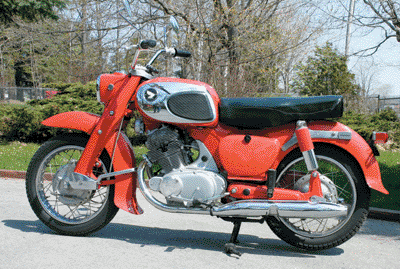
|
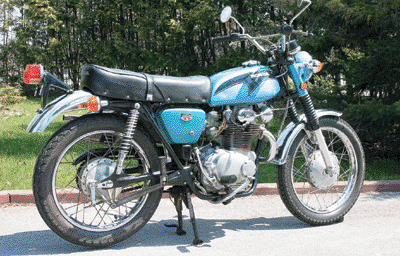
|
1971 Honda CL350
|
|
Overhead camshaft four-stroke twin cylinder.
The Scrambler version of Honda's popular 350 series with stylish
High-pipes.
|

|

|
1973 Honda CB350Four
|
|
Four stroke four cylinder, overhead camshaft with two valves per cylinder.
The smallest of Honda's original four-cylinder line up.
|

|
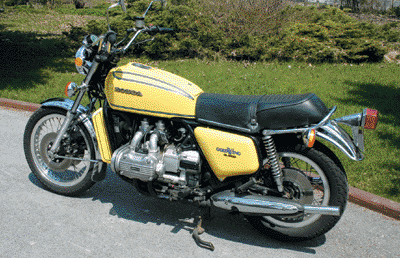
|
1976 Honda GL1000 Gold Wing
|
|
Four stroke, opposed four cylinder, overhead camshaft.
The first generation of the venerable Gold Wing series.
|
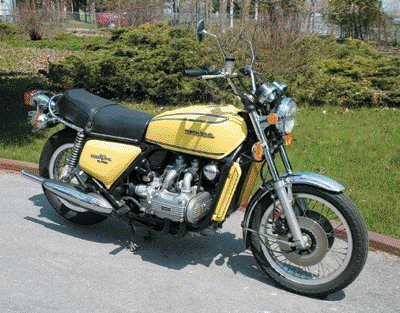 |
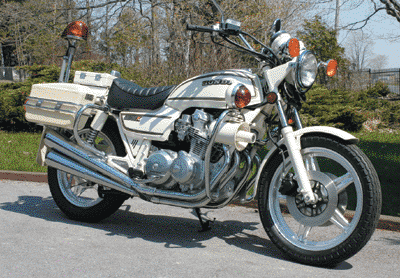
|
1980 Honda CB750 'Police Special'
|
|
Four stroke, four cylinder, double overhead camshaft with four valves per cylinder
Built on a trial basis for testing by various North American Police forces.
This bike is brand new.
|
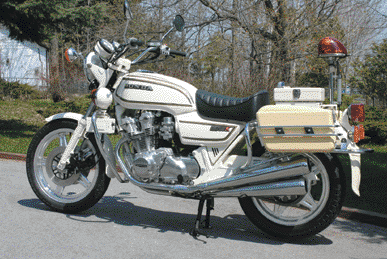
|

|
1980 Honda CBX |
|
Four stroke six cylinder, double overhead camshaft with four valves per cylinder.
Honda's first Open Class Superbike. Smooth, powerful but heavy. The fastest bike when introduced, it was soon relegated to Sport Touring status.
|

|
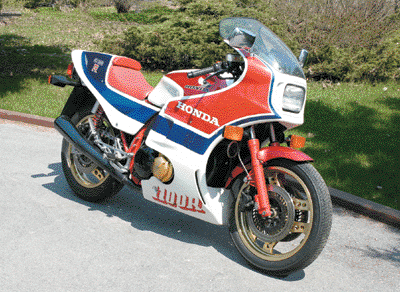
|
1984 Honda CB1100R
|
|
Four stroke four cylinder, with double overhead camshaft and four valves per cylinder. Rare European version of the CB1100. Imported from Scotland.The CB1100R were in a higher state of tune and featured lot's of exotic parts including Alloy gas tank and Carbon-Fiber bodywork.
|

|

|
1985 Honda VF1000R
|
|
Four stroke V-four cylinder, gear-driven double overhead camshaft with four valves per cylinder. When introduced this was the fastest production bike in the world. Featuring World Endurance Racing style quick-release front wheel clamps. |
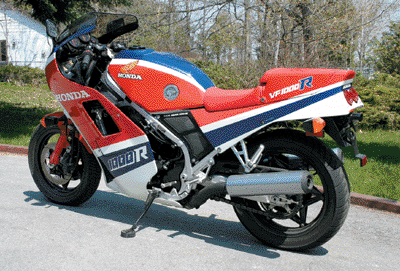
|
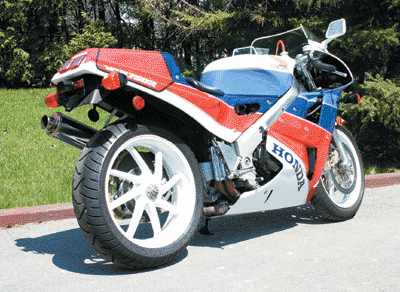
|
1989 Honda RC30
|
Four stroke V-four cylinder, gear-driven double overhead camshaft with four valves per cylinder.
Honda's first 'World Superbike Racing 'platform'. Very exotic and expensive in it's time.
Only 30 were brought to Canada to meet homologation rules.
|

|
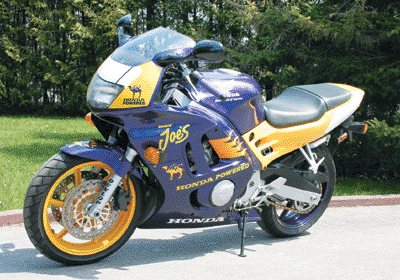
|
1996 Honda CBR600F3 Smokin Joes Limited Edition.
|
Four stroke four cylinder, double overhead camshaft with four valves per cylinder.
Liquid cooled.
Race-replica version of the standard CBR.
Built to celebrate Miguel Duhamels 1995 AMA 600 SuperSport Championship.
|
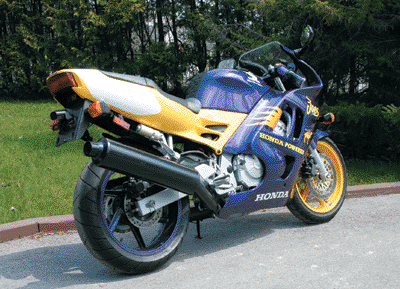
|
|
- top - end -
|
Kawasaki:
Kawasaki Heavy Industries, the parent company of the motorcycle division, is one of the largest industrial companies in the world making the motorcycle part of the business somewhat of a sideline.The company began as a shipyard 1878 founded by Shozo Kawasaki. Prior to World War I, it had branched out to produce locomotives, marine transportation, steel, aircraft and engines. After World War II, all divisions had work except the aircraft plant which still had skilled workers and production equipment. The plant began to produce motorcycle parts for other makers but in 1958 they decided to produce their own motorcycle. After much initial success in the Japanese motocross racing circuit, Kawasaki reluctantly chose to export as the Japanese market was flooded with lightweight motorcycles. With small displacement engines and nothing to set them apart from their competition resulted in disappointing sales in North America. Kawasaki knew that speed was important in the North American market but concluded that acceleration was key. In 1967 they released the twin cylinder two stroke 250cc Samurai and later released the larger twin 350cc Avenger. The later could drag down the 1/4 mile in 15 seconds at 100mph from a standing start. This machine set Kawasaki on the right path to be recognized by the American market.
Kawasaki continued with the quest for extreme acceleration and in 1968 released the 499cc H1, or Mach III. Their thinking was that if the twin cylinder was good, then three must be better. This two stroke engine propelled the H1 to the end of the 1/4 mile in less than 13 seconds. It was hard not to pop a wheelie on this bike. Straight line acceleration was very fast but unfortunately the bike could have used some help cornering. The short wheelbase combined with a frame that was not made to handle the very touchy power meant a very smooth throttle was needed in corners. Later models sported a 748cc with increased power although the frame was strengthened for better handling. The 900 Z1, like the one shown here, was released in 1972. In later years the smaller displacement three cylinders lost some of their raw acceleration and became more manageable to handle for the general buying public.
|

|
1969 Kawasaki Mach III
|
|
Piston port two stroke triple cylinder.
These legendary bikes where a huge jump in performance and quickly gained a reputation for wheelie producing power along with evil handling. They were the quickest Japanese bikes at the time. Authors note: This was one of the first motorcycles I rode in my teen years. The front wheel unexpectedly lifted off the ground while accelerating in third gear, resulting in a startling experience, even if it was just for a short moment.
|
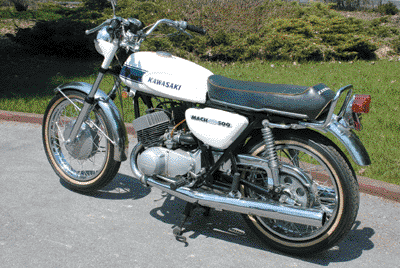
|

|
1971 Kawasaki A-7 Avenger.
|
Rotary valve two stroke twin cylinder.
Kawasaki's fastest two-stroke before the introduction of the Mach III 500. It was the quickest 350 of the day.
|

|
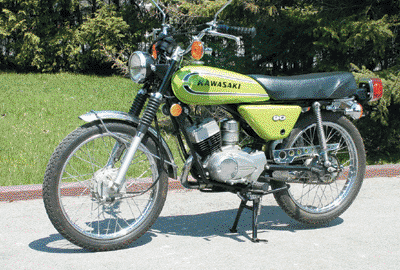
|
1974 Kawasaki G3
|
Rotary valve two stroke single cylinder.
Kawasaki's smallest street two stroke of the '70's. This bike was donated to the collection by the Dave Springett family.
|

|

|
1974 Kawasaki Z1 900
|
Four stroke four cylinder, double overhead camshaft with two valves per cylinder.
Instantly the King of Superbikes, these legendary bikes signalled the start of the Superbike era that continues to this day. Restored by David & Bar Hodgson
|
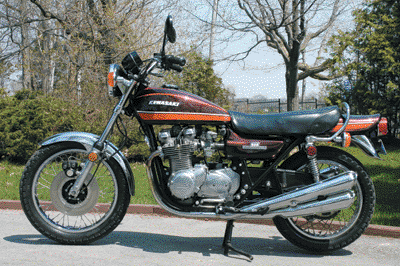
|
|
- top - end -
|
Suzuki:
Michio Suzuki, born in 1887, was an engineer and entrepreneur, starting his own business building silk looms at age 22. Unlike its modern competitors, Suzuki began to produce its first prototype engine in 1937 to produce Austin cars under license. The advent of World War II, however, meant the company had to change to produce equipment for the war effort dropping the engine development and Austin car production.Suzuki, like other fledgling motorcycle companies, began producing clip-on engines for the common bicycle although one difference remained, all components for the engines were made in the Suzuki factory. The first purpose built motorcycle from Suzuki without a clip-on engine was released in 1953. The ancillary engine ceased production in 1955 and the company concentrated its efforts to produce complete motorcycles. By 1955, Suzuki was the second largest motorcycle producer in Japan, Honda being the largest. Suzuki realized large gains in the 60's with their CCI (controlled crankshaft injection) system on their two-stroke engines whereby oil would be injected to where the engine needed it most depending on engine load and RPM. This allowed the consumer to fill the fuel tank with straight fuel eliminating the need to pre-mix oil and fuel. The two-stroke designs of Suzuki served them well but it became evident in the 70's that four-stroke was the direction the company had to go to stay competitive and because of the looming emission laws facing two-stroke engines. |

|
1963 Suzuki T-10 250
|
Piston port two stroke twin cylinder.
The earliest Suzuki 250 twin imported to North America featured
electric start and turn indicators.
It was the beginning of a long, successful line of two stroke 250's for Suzuki that lasted over 25 years. This all original bike was acquired from Dave Hall.
|

|
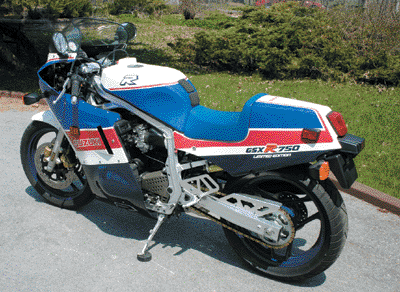
|
1986 Suzuki GSX-R750 LTD
|
|
Four stroke four cylinder, double overhead camshaft with four valves per cylinder. One of the first Suzuki Limited Production Sportbikes. These featured a higher tuned engine, dry clutch and lightweight components. Oil and air cooled. The GS750 was launched in 1976 and was the predecessor to the GSX released in 1980. Suzuki had an impressive race record in the late 70's and early 80's and decided in 1985 to produce a 'race replica', the GSX-R. Suzuki was arguably the first to manufacturer a true race replica for the general consumer.
|
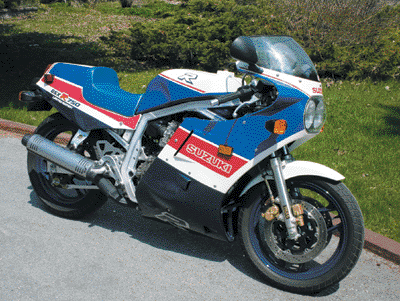 |
|
- top - end -
|
Yamaha:
It is doubtful that Torakusu Yamaha, born in 1851 and died in 1916, ever laid eyes on a motorcycle or anything powered by an internal combustion engine for that matter. Yamaha was an apprentice clockmaker and self employed engineer. He was asked to repair a school organ that led to the creation of a new company, Nippon Gakki, which used as its logo three crossed tuning forks. This new company was the forbearer of the huge musical instrument company Yamaha. After his death and many management changes, the leaders of the company in 1948 entered into the transport industry and began to produce small inexpensive motorcycles. The management decided to call the new company Yamaha after its founder. Because the motorcycle industry was in its infancy in Japan, the engineers turned to the European market for ideas and chose DKW (as many other manufacturers did) as its basis for design.Yamaha began to see increased consumer sales due to successful racing in Japan and Europe and were the first Japanese manufacturer to race in North America.
Yamaha produced many milestone models of which many spin-offs were derived. Yamaha developed the very successful DT (Dirt and Trail) line to capitalize on the off-road market that was sweeping North America. The DT line resulted in the competition YZ model of Motocross bikes in 1974. Another milestone bike was the 1969 release of the XS1. The XS1 was put in direct competition of the big British bikes like the Triumph T120 Bonneville. A later incarnation of the XS1 was the XS650, a better handling street bike of which the frame and engine were used in many different forms of racing. The long running YDS models transformed into the RD (Race Developed) line of two-stroke street bikes however were discontinued in 1980 due to emission regulations.
|
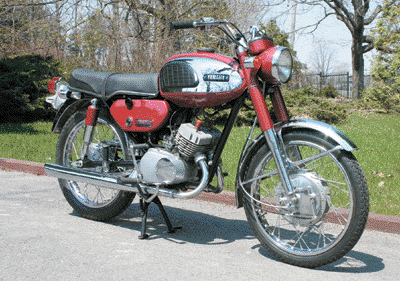
|
1967 Yamaha YCS1
|
Piston port two stroke twin cylinder.
One of the first Yamaha's to feature the Yamalube oil injection system and a Dynamo electric starter. This bike was restored with many new old stock parts.
|

|
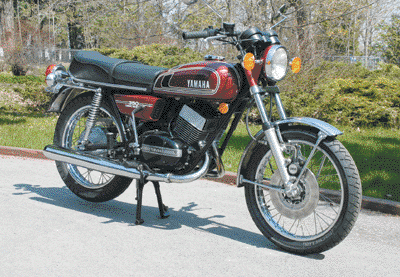
|
1976 Yamaha RD350
|
|
These very capable bikes and their descendants introduced many riders to their first high-performance motorcycle that would wheelie on demand.
|

|
Originally published in Motorcycle Mojo Magazine, by author and photographer Glenn Roberts, reproduced here with kind permission.
|

 Over the coming year we will be featuring an extensive photographic presentation of bikes from the Bar Hodgson Collection assembled by country of origin as originally published in Motorcycle Mojo Magazine, author and photographer Glenn Roberts, reproduced here with kind permission. This presentation of the fifth in the series features the Japanese motorcycles originally published in the July/Aug. 2005 issue of Motorcycle Mojo Magazine.
Over the coming year we will be featuring an extensive photographic presentation of bikes from the Bar Hodgson Collection assembled by country of origin as originally published in Motorcycle Mojo Magazine, author and photographer Glenn Roberts, reproduced here with kind permission. This presentation of the fifth in the series features the Japanese motorcycles originally published in the July/Aug. 2005 issue of Motorcycle Mojo Magazine. 




































